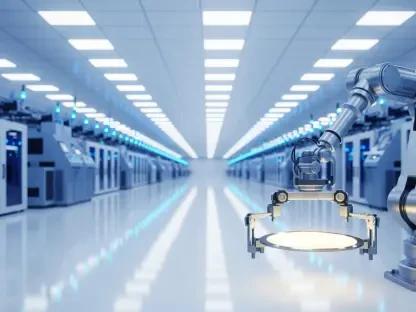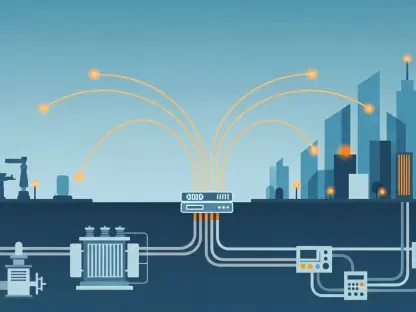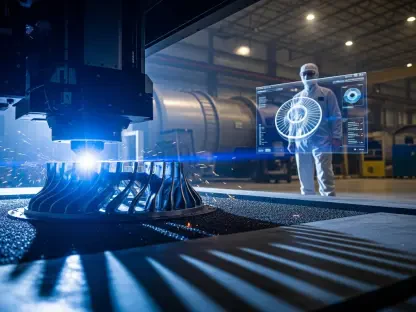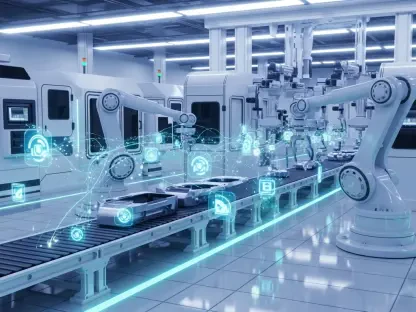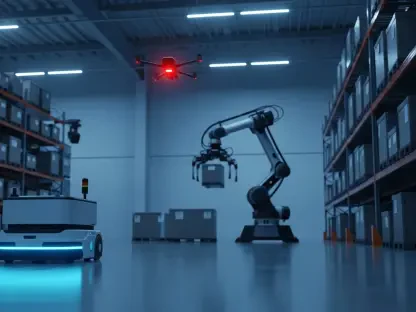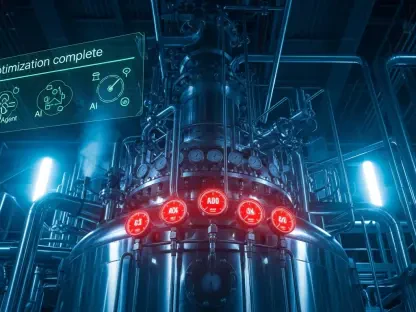In an era where the manufacturing industry grapples with a profound skills shortage, driven by retiring experts and the lightning-fast pace of technological change, Toyota Motor Manufacturing UK emerges as a beacon of innovation with its training academy at the Burnaston plant in Derbyshire, UK. This initiative isn’t merely a temporary fix to fill vacant roles; it represents a seismic shift in how workforce development is perceived, placing it on par with the transformative impact of the Toyota Production System (TPS) that redefined industrial efficiency. Partnering with Rockwell Automation, Toyota is crafting a future-ready workforce by addressing the critical gaps in talent and expertise that threaten global manufacturing stability. The Burnaston academy stands as a bold response to an urgent crisis, weaving together cutting-edge technology, strategic training models, and a deep commitment to preserving institutional knowledge. Far from a conventional program, this effort seeks to set a new benchmark for the sector, with implications that ripple beyond the company’s own operations into the broader industrial landscape. The approach taken here could very well inspire a reimagining of how talent is cultivated in an age of relentless innovation.
Tackling the Industry-Wide Skills Crisis
Toyota’s Burnaston plant, employing over 300 maintenance personnel, faces the same daunting challenge as much of the manufacturing world: a dwindling pool of skilled workers compounded by the retirement of seasoned engineers who carry irreplaceable knowledge. Sarah Channing, Section Manager of HR at Toyota Motor Manufacturing UK, underscores the difficulty in sourcing multi-skilled individuals capable of meeting the complex demands of modern production environments. The academy serves as a proactive countermeasure, building a robust talent pipeline that includes apprentices from diverse backgrounds—school leavers, internal production staff transitioning to new roles, and experienced hires from external organizations. This strategy ensures a balanced workforce, blending youthful enthusiasm with veteran insights to maintain operational continuity. By cultivating talent internally, Toyota mitigates the risk of demographic imbalances and secures a steady flow of capable personnel ready to step into critical roles as older workers phase out.
Beyond immediate staffing solutions, the academy addresses a deeper systemic issue by fostering a culture of long-term skill development tailored to industry needs. The focus isn’t just on replacing retiring staff but on creating a sustainable model that anticipates future shortages before they become crises. This multi-faceted recruitment approach also brings fresh perspectives into the fold, as external hires contribute diverse experiences that enrich the learning environment. The result is a workforce that’s not only equipped to handle current challenges but also adaptable to evolving demands, positioning Toyota as a leader in strategic human capital management within manufacturing. This forward-thinking mindset challenges the reactive hiring practices often seen in the sector, offering a blueprint for others to emulate in building resilient teams.
Blending Theory with Hands-On Expertise
Central to Toyota’s training philosophy at Burnaston is a hybrid model that seamlessly integrates classroom instruction with practical, on-the-job experience over a comprehensive four-year program. Initially, apprentices spend two years at a dedicated training center, collaborating with institutions like Burton and South Derbyshire College to master technical competencies such as programmable logic controllers (PLCs) and essential behavioral skills like problem-solving and fault diagnosis. This foundational phase ensures a strong theoretical grounding, preparing participants for the intricacies of industrial systems before they encounter real-world pressures. The curriculum is meticulously designed to cover both mechanical and electrical disciplines, equipping trainees with a versatile skill set that aligns with the multifaceted nature of modern manufacturing roles.
Following this, the subsequent two years shift focus to immersive, on-site training at Toyota’s facilities or those of partner companies, where apprentices apply their knowledge directly in live production settings. This practical exposure bridges the gap between abstract concepts and tangible outcomes, honing their ability to navigate complex machinery and troubleshoot issues in real time. Philip Smith, Team Leader Senior for Technical Skills Development, emphasizes the value of training on contemporary equipment, reflecting recent upgrades in hardware as part of a preventative maintenance strategy. This hands-on component ensures graduates emerge not just as theorists but as capable practitioners, ready to contribute effectively from day one. The balance struck between these learning modes distinguishes Toyota’s approach, creating well-rounded professionals equipped for the dynamic challenges of the shop floor.
Harnessing Advanced Technology for Training
A pivotal element of the Burnaston academy’s effectiveness lies in its strategic collaboration with Rockwell Automation, which supplies state-of-the-art tools integral to both training and operational processes at the plant. Technologies such as Allen-Bradley hardware, encompassing PLCs, drives, and human-machine interface (HMI) systems for automated guided vehicles in the press shop, form the backbone of the learning experience. This partnership ensures that apprentices engage with current-generation systems rather than outdated machinery, aligning their skills with industry standards. Philip Smith highlights how access to operational data through updated hardware fosters a proactive stance on maintenance, enabling trainees to anticipate and resolve issues before they escalate, a critical competency in high-stakes manufacturing environments.
This emphasis on cutting-edge technology extends beyond mere familiarity with tools; it cultivates a mindset of adaptability crucial for navigating future innovations. By embedding real-time data analysis and modern automation solutions into the curriculum, Toyota prepares its workforce for the digital transformation sweeping the sector. The result is a cohort of graduates who are not only proficient in today’s systems but also poised to embrace emerging advancements, ensuring long-term relevance in their careers. This tech-forward approach sets a high bar for training programs, demonstrating how strategic partnerships can elevate workforce readiness. It also underscores Toyota’s commitment to staying at the forefront of industrial progress, equipping its personnel with the tools and knowledge to drive efficiency and innovation in equal measure.
Prioritizing Depth Over Scale in Education
Despite an influx of applications far exceeding the 12 annual spots available at the Burnaston academy, Toyota steadfastly prioritizes quality over quantity in its training philosophy. Sarah Channing elaborates on the deliberate choice to maintain small class sizes, which allows for intensive, personalized mentoring and prevents an imbalance in the teacher-to-pupil ratio. This approach also ensures that the shop floor isn’t overwhelmed with too many trainees during practical phases, preserving the effectiveness of hands-on learning. By focusing on depth rather than breadth, Toyota creates an environment where each apprentice receives tailored guidance, fostering skill mastery and confidence that translate into exceptional performance on the job.
The impact of this selective strategy is evident in the strong outcomes achieved by graduates, coupled with impressive retention rates that reflect the program’s success in nurturing committed professionals. This contrasts sharply with broader industry tendencies to scale up training numbers at the expense of individual attention, often diluting the quality of instruction. Toyota’s model challenges such norms, proving that a concentrated focus on fewer, well-trained individuals yields superior results in both capability and loyalty. The emphasis on high standards over high volume redefines efficiency in workforce development, offering a compelling case for other manufacturers to reconsider their own training frameworks. It’s a testament to the belief that investing deeply in human capital delivers returns that far outweigh the allure of mass recruitment.
Safeguarding Knowledge Through Mentorship
As experienced workers at Burnaston approach retirement, Toyota recognizes the urgent need to capture their decades of tacit expertise before it vanishes from the organization. A key mechanism for this is involving near-retirees in the development of training content and positioning them as mentors to younger apprentices. Sarah Channing notes that this process transforms invaluable, often unspoken know-how into structured, teachable material, preserving institutional memory for future generations. This initiative not only mitigates the risk of knowledge loss—a recognized challenge across industries—but also enriches the curriculum with real-world insights that textbooks alone cannot provide, ensuring continuity in operational excellence.
Moreover, the mentorship model fosters a collaborative culture within the workforce, bridging generational divides through direct interaction between seasoned veterans and emerging talent. This dynamic creates a learning ecosystem where practical wisdom is passed down, enhancing the apprentices’ ability to tackle complex challenges with a nuanced perspective. The personal connection built through mentorship also instills a sense of belonging and purpose among newer employees, reinforcing their commitment to the company’s goals. Toyota’s focus on knowledge retention through such interpersonal exchanges sets it apart as a steward of legacy in an era of rapid turnover. By embedding this practice into its training framework, the academy ensures that critical expertise remains a living asset, continually shaping the skills and ethos of its workforce.
Extending Impact to Community and Industry
Toyota’s vision for workforce development transcends the boundaries of its Burnaston plant, creating a broader positive influence on local communities and the manufacturing sector at large. Through partnerships with schools, the academy engages children as young as nine in STEM (Science, Technology, Engineering, and Mathematics) activities, igniting early interest in technical fields. Some of these young participants later join as apprentices, illustrating the long-term value of such outreach in building a talent pipeline from the ground up. This community engagement not only addresses regional skills gaps but also positions Toyota as a catalyst for educational and economic growth in Derbyshire and beyond.
Additionally, collaborations with prominent UK engineering and retail companies amplify the program’s reach, establishing a shared training ecosystem. Core skills are taught at Toyota, while specialized instruction occurs at partner sites, culminating in recognized qualifications such as Level 3 or advanced apprenticeships as engineering technicians. This cooperative model ensures that the benefits of Toyota’s rigorous training extend across industries, tackling widespread shortages while fostering transferable competencies. The ripple effect of these partnerships strengthens the overall manufacturing landscape, demonstrating how collective efforts can yield sustainable solutions. Toyota’s commitment to this broader impact highlights a strategic understanding that nurturing talent is not just an internal priority but a shared responsibility with far-reaching implications for industry resilience.
Strategically Embracing Technological Evolution
Rather than adopting every new digital tool indiscriminately, Toyota employs a discerning approach to technology integration at Burnaston, focusing on solutions that offer clear operational benefits. Philip Smith explains that a dedicated on-site team rigorously evaluates digital innovations to ensure alignment with specific needs, avoiding unnecessary complexity. This pragmatic stance reflects a nuanced understanding of technology’s role in manufacturing, prioritizing value over trendiness. Yet, the rapid evolution of industrial tech presents a constant challenge, requiring the academy to remain agile in anticipating shifts that could redefine production processes in the coming years.
Sarah Channing emphasizes the importance of staying ahead of these trends by continuously updating training curricula to reflect emerging technologies, ensuring that graduates are prepared for future demands rather than just current realities. This forward-looking perspective positions the academy as a leader in workforce readiness, equipping apprentices with the adaptability to thrive amid ongoing digital transformation. By balancing selective adoption with proactive preparation, Toyota avoids the pitfalls of technological lag or overreach, maintaining a competitive edge in training efficacy. This strategic focus on future-readiness not only benefits the company but also sets a standard for how training programs can evolve in step with industry advancements, ensuring sustained relevance in a fast-changing environment.
Pioneering a New Era in Industrial Training
Reflecting on Toyota’s efforts at Burnaston, it’s clear that the academy marks a turning point in how manufacturing approaches workforce development, treating it not as an expense but as a vital competitive advantage. The blend of theoretical and practical training, underpinned by access to cutting-edge technology, equips a new generation of workers to handle the complexities of modern industry with skill and confidence. Mentorship initiatives ensure that the wisdom of retiring experts is captured and passed on, preserving a legacy of excellence that shapes every apprentice who walks through the program’s doors.
Looking ahead, the model established at Burnaston offers actionable insights for the broader sector, urging companies to invest strategically in human capital with the same rigor applied to production systems. Exploring partnerships, as Toyota did with local schools and industry players, could amplify the reach of such programs, addressing skills shortages on a wider scale. Equally critical is the need to anticipate technological shifts, adapting training to prepare workers for innovations yet to come. Toyota’s journey at Burnaston serves as an invitation to rethink training as a cornerstone of industrial success, paving the way for sustainable growth and resilience in an ever-evolving landscape.


